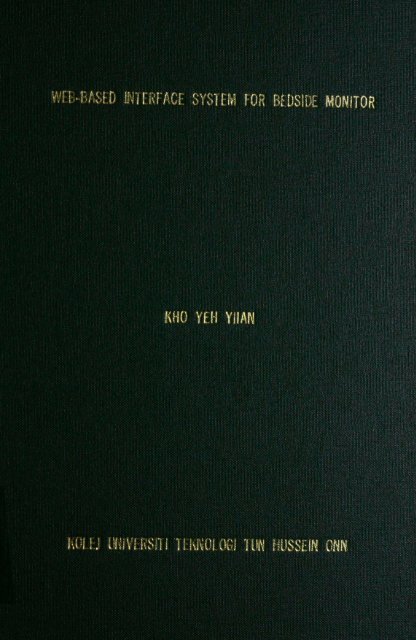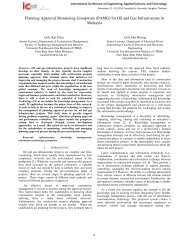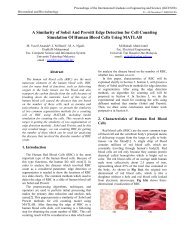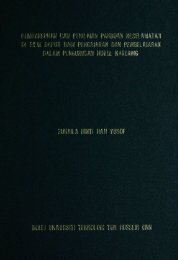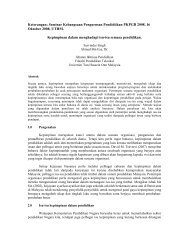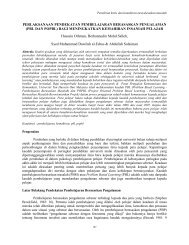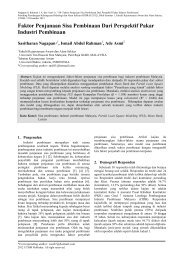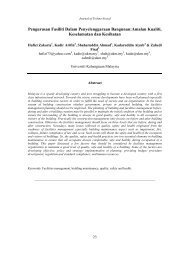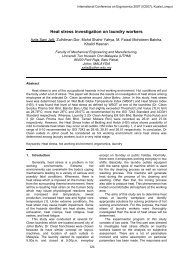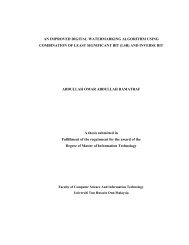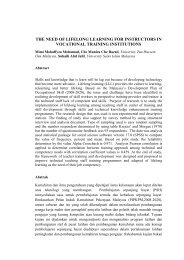borang pengesahan status tesis
borang pengesahan status tesis
borang pengesahan status tesis
Create successful ePaper yourself
Turn your PDF publications into a flip-book with our unique Google optimized e-Paper software.
KHO YEH YUAN<br />
IUHJ llliVlifSni liKROIOSi nw HUSSEW OWN
^ ^ S P H S ^ r "
KOLEJ UNIVERSITI TEKNOLOGI TUN HUSSEIN ONN<br />
BORANG PENGESAHAN STATUS TESIS*<br />
JUDUL: WEB-BASED INTERFACE SYSTEM FOR BEDSIDE MONITOR<br />
SESI PENGAJIAN: 2004/2005<br />
Saya KHO YEH YIIAN<br />
(HURUF BESAR)<br />
mengaku membenarkan <strong>tesis</strong> (PSM/Saij ana/Doktor Falsafah)* ini disimpan di Perpustakaan<br />
dengan syarat-syarat kegunaan seperti berikut:<br />
1.<br />
2.<br />
3.<br />
4.<br />
Tesis adalah hakmilik Kolej Universiti Teknologi Tun Hussein Onn.<br />
Perpustakaan dibenarkan membuat salinan untuk tujuan pengajian sahaja.<br />
Perpustakaan dibenarkan membuat salinan <strong>tesis</strong> ini sabagai pertukaran antara institusi<br />
pengajian tinggi.<br />
**Sila tandakan {/)<br />
1 | SULIT (Mengandungi maklumat yang berdaijah keselamatan atau<br />
kepentingan Malaysia seperti yang termaktub di dalam<br />
(AKTA RAHSIA RASMI 1972)<br />
| | TERHAD (Mengandungi maklumat TERHAD yang telah ditentukan<br />
oleh organisasi/badan di mana penyelidikan dijalankan)<br />
1 V 1 TIDAK TERHAD<br />
(TANDATANGA^ PENULIS)<br />
Alamat tetap:<br />
18. PERSIARAN 16.<br />
PERSIARAN BROOKE,<br />
96000 SIBU.<br />
SARAWAK.<br />
Disahkan oleh<br />
(TANDAT/ik(MN PENYELIA)<br />
PROF DR HASHIM BIN SAIM<br />
Nama Penyelia<br />
Tarikh: 28 MAC 2005 Tarikh: 28 MAC 2005<br />
CATATAN: * Potong yang tidak berkenaan.<br />
** Jika <strong>tesis</strong> ini SULIT atau TERHAD, sila lampirkan surat daripada pihak<br />
berkuasa/organisasi berkenaan dengan menyatakan sekali sebab dan<br />
tempoh <strong>tesis</strong> ini perlu dikelaskan sebagai SULIT atau TERHAD.<br />
• Tesis dimaksudkan sebagai <strong>tesis</strong> bagi Ijazah Doktor Falsafah dan<br />
Saijana secara penyelidikan, atau disertasi bagi pengajian secara keija<br />
kursus dan penyelidikan, atau Laporan Projek Saijana Muda (PSM).
"Saya/Kami akui bahawa saya/kami telah membaca karya ini dan pada pandangan<br />
saya/kami karya ini adalah memadai dari segi skop dan kualiti untuk tujuan<br />
pengaugerahan Ijazah Saijana Kejuruteraan (Elektrikal)."<br />
Tandatangan<br />
Nama Penyelia I<br />
Tarikh<br />
Tandatangan<br />
Nama Penyelia II<br />
Tarikh<br />
Profesor Dr. HWhim Bin Saim<br />
28 Mac 2005<br />
Soon Chin Fhong<br />
28 Mac 2005
WEB-BASED INTERFACE SYSTEM FOR<br />
BEDSIDE MONITOR<br />
KHO YEH YUAN<br />
A thesis submitted<br />
in fulfillment of the requirements for the award of the<br />
Degree of Master of Engineering (Electrical)<br />
Faculty of Electrical and Electronic Engineering<br />
Kolej Universiti Teknologi Tun Hussein Onn<br />
MARCH, 2005
"No part of the study was covered by copyright. References of information obtained<br />
from other source are specially quoted, otherwise the rest of the information<br />
presented through this study is the sole work and experimentation carried out by the<br />
Signature<br />
Author<br />
Date<br />
author"<br />
KHO YEH YTDLAN<br />
28 March 2005
for my beloved parents, brothers and Chee Kiong, may God shower uncountable<br />
blessings upon all of you
ACKNOWLEDGEMENT<br />
I would like to express my sincere gratitude to Prof. Dr Hashim bin Saim, my<br />
supervisor and Mdm Soon Chin Fhong, my co-supervisor for their invaluable<br />
guidance and advice throughout this research and all of my work with them and for<br />
helping to move this process forward as quickly as possible. I would like to thank<br />
Mr. Tang Tung Yan for providing input and advices. My parents have always been a<br />
great source of encouragement in believing that I can accomplish whatever I want.<br />
For my beloved late brother Yeh Wei, I would also like to thank you for everything.<br />
I would like to take this opportunity to thank also my husband, Mr Sia Chee<br />
Kiong for his patience with me all this while. In addition, I would like to thank<br />
others who have indirectly contributed to the completion of this research such as the<br />
medical laboratory technician, Mr. Ahyat for providing help whenever I needed to.<br />
And also to all my friends, a big thank you to all of you for being my "patients".<br />
There are also many other people that have provided me help and support and one<br />
time or another that I should also thank, but the list would grow too long.<br />
Many thanks and good luck to everyone.
ABSTRACT<br />
From face-to-face consultation to medicine at a distance, technology is<br />
changing the way medical services are delivered to the people. We are going into an<br />
era where the information is being digitized to be stored in a database. This is done<br />
in order to reduce information overlap and redundancy that are the main problems<br />
the health care sector are facing right now. More hospitals in other more advanced<br />
countries are going paperless. In order to provide better services to the critically ill<br />
patients in the ICU or CCU, a data acquisition program is developed for the<br />
acquisition of vital signs monitored in the critical care units. This work discusses the<br />
work done in extracting the data and signal from patient monitor BSM 8800 to the<br />
computer. The data are acquired using RS232C Interface Protocol. The vital signs<br />
acquired include oxygen saturation (SaCh), heart rate (HR), electrocardiograph<br />
(ECG) signal, non-invasive blood pressure (NIBP), respiration rate (RR),<br />
temperature (TEMP) and end tidal carbon dioxide (PETCO2 or ETCO2). Ventricular<br />
Premature Contraction (VPC), ST level and arrhythmia information are also acquired<br />
and displayed to provide a more thorough information on the condition of the<br />
patients. Alarm detection is also programmed so that in critical conditions the vital<br />
signs will be displayed in red for extra caution. An ECG user control is designed<br />
and embedded in the web page in order to convert and plot the ECG waveform from<br />
hexadecimal values sent from the bedside monitor. The user control has been tested<br />
its accuracy and proved its validity to reconstruct the original ECG waveform. Basic<br />
patient information can also be seen from the graphical user interface (GUI) that has<br />
been developed. Physicians and medical practitioners have to register with the<br />
system before gaining access to the system and only the physician-in-charge of the<br />
patient can see the more intricate details of the patient.
ABSTRAK<br />
Teknologi sedang mengubah cara peijumpaan pesakit dengan doktor secara<br />
konvensional kepada cara rawatan dari lokasi lain sedikit demi sedikit. Kita sedang<br />
menuju ke era di mana maklumat ditukar kepada bentuk digital untuk disimpan<br />
dalam pangkalan data. Ini adalah bertujuan mengurangkan informasi dan maklumat<br />
yang sama difailkan dua kali. Sektor perubatan kini sedang menghadapi masalah<br />
perlapisan data serta data lapuk yang tidak dikemaskinikan. Hospital di negara-<br />
negara maju telahpun lama mengaplikasikan cara penyimpanan rekod secara digital<br />
untuk mengelakkan pembaziran kertas. Bagi memberikan rawatan yang lebih baik<br />
kepada pesakit-pesakit di unit-unit kecemasan, satu program untuk mendapatkan<br />
data pesakit untuk pemeriksaan doktor dan jururawat dibangunkan. Tesis ini<br />
membincangkan keija yang dibuat untuk mendapatkan data tersebut daripada BSM<br />
8800 kepada komputer. Data didapatkan melalui protokol RS232C yang<br />
membolehkan komunikasi antara alatan dengan komputer. Data yang didapatkan<br />
termasuk kepekatan oksigen (Sa02 atau Sp02), kadar denyutan (HR),<br />
elektrocardiograf (ECG), tekanan darah (NIBP), kadar respirasi (RR), suhu badan<br />
(TEMP) dan kepekatan karbon dioksida dalam darah (ETC02 atau PETC02).<br />
Kontraksi ventrikel awalan (VPC), tahap ST dan maklumat mengenai ECG yang<br />
tidak normal turut didapatkan bagi mengetahui keadaan pesakit yang lebih<br />
menyeluruh. Di kala teijadinya kecemasan, data akan terpapar dalam warna merah.<br />
Satu program bagi menukarkan maklumat dalam bentuk heksa kepada voltan ECG<br />
yang sepatutnya dibangunkan. Ia diuji dalam ketepatannya dan terbukti bahawa<br />
ianya boleh dipercayai untuk menghasilkan gelombang ECG yang sama seperti yang<br />
sebenar. Maklumat mengenai pesakit serta doktor yang merawat terdapat dalam<br />
laman web yang dihasilkan. Doktor haruslah mendaftarkan diri sebelum boleh<br />
mengakses laman web tersebut. Hanya doktor yang bertanggungjawab terhadap<br />
seseorang pesakit boleh membaca maklumat pesakit yang lebih terperinci.
CONTENTS<br />
CHAPTER ITEM PAGE<br />
TITLE PAGE i<br />
TESTIMONY ii<br />
DEDICATION iii<br />
ACKNOWLEDGEMENT iv<br />
PAPERS PUBLISHED ARISING FROM THIS v<br />
WORK<br />
ABSTRACT vi<br />
ABSTRAK vii<br />
CONTENTS viii<br />
LIST OF TABLES xiii<br />
LIST OF FIGURES xv<br />
LIST OF ABBREVIATIONS xvii<br />
LIST OF APPENDICES xix<br />
I INTRODUCTION<br />
1.1 Background 1<br />
1.2 Definition of Tide 3<br />
1.3 Problem Statement 4<br />
1.4 Objectives 6<br />
1.5 Scope of Work 6<br />
1.6 Proposed Method 12<br />
1.7 Thesis Organization 12
II AN OVERVIEW OF VITAL SIGNS<br />
MONITORED IN ICU/CCU<br />
2.1 Vital Signs in the ICU/CCU 14<br />
2.2 Electrocardiograph 14<br />
2.3 Pulse / Heart Rate 18<br />
2.4 Oxygen Saturation 18<br />
2.5 Respiration Rate 19<br />
2.6 End Tidal Carbon Dioxide 19<br />
2.7 Non Invasive Blood Pressure 21<br />
2.8 Temperature 22<br />
2.9 ST Level and Ventricular Premature 23<br />
Contraction<br />
2.10 Brief Overview of the Conditions in ICU/CCU 24<br />
2.11 Conclusion 26<br />
III REVIEW OF LITERATURES<br />
3.1 Introduction to Telemedicine 27<br />
3.2 Wireless Technologies 31<br />
3.3 Components in Telemedicine Applications 36<br />
3.3.1 Computer Based Records and Critical 36<br />
Care Databases<br />
3.3.2 User Interface 41<br />
3.3.3 Systems Integration and Standards 42<br />
3.3.4 Telemedicine Architecture 43<br />
3.4 Requirements for Web-based Systems 43<br />
3.4.1 Requirements to Information Security 44<br />
3.4.2 Requirements to Communication 45<br />
Technology<br />
3.5 Related Works 47<br />
3.6 Telemedicine Assessment 51<br />
3.7 Summary 53
IV METHODOLOGY<br />
4.1 Introduction 55<br />
4.2 Programming Languages and Tools Used in 63<br />
Project Development<br />
4.2.1 Visual Basic 6 (VB6) 63<br />
4.2.2 SoftWIRE Technology 64<br />
4.2.3 Active Server Pages 64<br />
4.2.4 Structured Query Language (Sequel or 66<br />
SQL)<br />
4.2.5 MS Access 97 66<br />
4.2.6 ActiveX Technology 67<br />
4.3 Data Acquisition from Patient Monitor Unit 69<br />
4.3.1 BSM 8800 RS232C Cable 69<br />
4.3.2 RS232C Interface Protocol for Patient 69<br />
Monitoring System<br />
4.3.3 Visual Basic Communication Tool 70<br />
4.3.4 ECG Waveform Sequential Data 73<br />
Acquisition<br />
4.3.5 Other Vital Signs Data Acquisition 76<br />
4.3.6 Non-Invasive Blood Pressure Data 78<br />
Acquisition<br />
4.4 Patient Database Development 78<br />
4.4.1 Introduction 78<br />
4.4.2 Patient Database Fields Determination 79<br />
4.4.3 Unnormalized Form 80<br />
4.4.4 First Normal Form 81<br />
4.4.5 Second Normal Form 82<br />
4.4.6 Third Normal Form 82<br />
4.4.7 Data Dictionary 83<br />
4.5 Web Pages Development 84<br />
4.5.1 Basic Interface Design 84<br />
4.5.2 Coding With ASP 84<br />
4.5.3 Creating an ActiveX Control for ECG 84
Graph<br />
4.5.4 Data Extraction of the Vital Signs 86<br />
4.5.5 Testing the Program and Web Pages 89<br />
4.6 Project Specification Summary 89<br />
4.7 Conclusion 91<br />
V RESULT ANALYSIS AND DISCUSSIONS<br />
5.1 Introduction 92<br />
5.2 VB Communication Tool Results 92<br />
5.3 Web-based Interface System Screen Captures 94<br />
5.4 MS Access Database 115<br />
5.5 Configuring nS5 115<br />
5.6 Validation of the ECG Graph Control 116<br />
5.6.1 Validation Using Simulated ECG 116<br />
Signals in Non-noisy Environment<br />
5.6.2 Validation Using Simulated ECG 123<br />
Signals in Noisy Environment<br />
5.6.3 Simulated ECG Signals Analysis 130<br />
Results<br />
5.6.4 Validation Using Real Patient ECG 137<br />
Signals<br />
5.6.5 Real Patient ECG Signals Analysis 142<br />
Results<br />
5.7 Other Vital Signs Validation 144<br />
5.8 Conclusion 146<br />
VI CONCLUSION AND FUTURE DEVELOPMENT<br />
6.1 Research Summary 147<br />
6.2 Conclusion 148<br />
6.3 Suggestion For Future Development 148
REFERENCES<br />
APPENDIX A-O<br />
150<br />
161-277
LIST OF TABLES<br />
TABLE TITLE PAGE<br />
2.1 Electrode Positions and Connections for Standard ECG 16<br />
Leads<br />
2.2 Difference between Normal and Abnormal Capnogram 20<br />
2.3 Description of Different Phases of A Capnogram 20<br />
2.4 Functions of the Intensive Care Complex 25<br />
3.1 Wireless Connectivity Technologies 33<br />
3.2 Challenges of Creating Critical Care Databases 39<br />
3.3 Reasons for Slow Adoption of New Signal Processing 40<br />
Method<br />
3.4 Measures Taken to Protect Patient Data 44<br />
3.5 Important Aspects in Telemonitoring Applications 48<br />
4.1 Main Components in Access 97 67<br />
4.2 Code to Send and Receive Data Continuously from Patient 71<br />
Monitor<br />
4.3 Coding to Send Request Out from PC 73<br />
4.4 Waveform Information Sequential File Summary 74<br />
4.5 Format Summary of ECG Waveform Sequential Line 74<br />
4.6 Example of Numerical and Alarm Data 77<br />
4.7 Database Normalization Reasons 79<br />
4.8 Unnormalized Form 80<br />
4.9 First Normal Form 81<br />
4.10 Second Normal Form 82<br />
4.11 Third Normal Form 83<br />
4.12 Procedures for Creating an ActiveX Control 86<br />
4.13 Project Specification Summary 89
5.1 Numerical and Alarm Data Output 108<br />
5.2 Network Connection Settings 116<br />
5.3 Comparison Table for Normal Sinus Rhythm 117<br />
5.4 Comparison Table for Asynchronous Waveform 118<br />
5.5 Comparison Table for Second Degree Block 118<br />
5.6 Comparison Table for Left Bundle Branch Block 119<br />
5.7 Comparison Table for Right Bundle Branch Block 120<br />
5.8 Comparison Table for Atrial Flutter 120<br />
5.9 Comparison Table for AV Sequential 121<br />
5.10 Comparison Table for Nodal Rhythm 121<br />
5.11 Comparison Table for Supraventricular Tachycardia 122<br />
5.12 Comparison Table for PVC 24 min 123<br />
5.13 Comparison Table for Normal Sinus Rhythm With Noise 124<br />
5.14 Comparison Table for Asynchronous Waveform With 124<br />
Noise<br />
5.15 Comparison Table for Second Degree Block With Noise 125<br />
5.16 Comparison Table for Left Bundle Branch Block With 126<br />
Noise<br />
5.17 Comparison Table for Right Bundle Branch Block With 127<br />
Noise<br />
5.18 Comparison Table for Atrial Flutter With Noise 127<br />
5.19 Comparison Table for AV Sequential With Noise 128<br />
5.20 Comparison Table for Nodal Rhythm With Noise 128<br />
5.21 Comparison Table for Supraventricular Tachycardia With 129<br />
Noise<br />
5.22 Comparison Table for PVC 24 min With Noise 130<br />
5.23 Comparison Table for Male A 137<br />
5.24 Comparison Table for Male B 138<br />
5.25 Comparison Table for Male C 139<br />
5.26 Comparison Table for Female D 139<br />
5.27 Comparison Table for Female E 140<br />
5.28 Comparison Table for Female F 141<br />
5.29 Testing the Validation of Other Vital Signs Display 144
LIST OF FIGURES<br />
FIGURE ITEM PAGE<br />
1.1 Total Hospital Information System Concept 9<br />
1.2 Integration Concept for Monitoring 8<br />
1.3 Scope of Project 10<br />
1.4 Overall System Architecture of Proposed Monitoring 13<br />
System<br />
2.1 A Typical ECG Waveform 15<br />
2.2 Einthoven's Triangle 17<br />
2.3 Normal Capnogram 20<br />
4.1 Overall System Setup 55<br />
4.2 Aloka SSD-200 Ultrasound System 56<br />
4.3 Stryker Endoscopy Model 688i 57<br />
4.4 Other Equipments That Are Switched On 57<br />
4.5 Flow Chart of Data Acquisition and Display 59<br />
4.6 Patient Database Web Page Development Flow Chart 60<br />
4.7 Web Page Program Flow 61<br />
4.8 Entry Drop Down Menu 62<br />
4.9 Reports List 62<br />
4.10 Tools List 62<br />
4.11 A COM Object 68<br />
4.12 Basic Interface Design 70<br />
4.13 ECG Waveform Sequential Files 75<br />
4.14 Basic Web Page Interface Design 85<br />
5.1 VB Communication Tool Interface 93<br />
5.2 Login Interface 94<br />
5.3 New User Registration Interface 95
5.4 Overview of the System Developed 96<br />
5.5 Patient Details Summary Page 97<br />
5.6 Enter Patient Information Page 97<br />
5.7 Deleting a Patient Record 98<br />
5.8 Searching Through Records Using Patient Name 98<br />
5.9 Results of Search Using Patient Name 99<br />
5.10 Searching Through Records Using Patient Code 99<br />
5.11 Results of Search Using Patient Code 100<br />
5.12 Physician Details Entry Form 101<br />
5.13 Physician Summary Page and Search Using Physician 101<br />
Name<br />
5.14 Results of Search Using Physician Name 102<br />
5.15 Results of Search Using Physician Code 103<br />
5.16 List of Patients Registered in the System 103<br />
5.17 Admit New Patient Under Physician's Own Account 104<br />
5.18 Patient Examinations for Physician Sam Mokhtar 105<br />
5.19 Examination Types 106<br />
5.20 Others Examination Type 106<br />
5.21 Examination and Findings Report 107<br />
5.22 Patient ICU Findings and Exams 107<br />
5.23 Search Unreleased Patients According to Date of 109<br />
Admission<br />
5.24 Discharge Patient Interface 109<br />
5.25 Released Patients List 110<br />
5.26 Reports Generated By System 110<br />
5.27 Print Patient List HI<br />
5.28 Patient Code List Report 111<br />
5.29 Daily Admission List According to Date 112<br />
5.30 Daily Admission Report 1 12<br />
5.31 List of Released Patients According to Date 113<br />
i<br />
5.32 Released Patients Report 113<br />
5.33 Useful Links to Other medical Websites 114<br />
5.34 About the System 114<br />
5.35 MS Access 97 Database Tables 115
LIST OF ABBREVIATIONS<br />
ADO ActiveX Data Object<br />
ASCII American Standard Code for Information Interchange<br />
ASF Active Server Pages<br />
AV Atrioventricular<br />
CCS Critical Care System<br />
CCU Coronary Care Unit<br />
CIS Clinical Information System<br />
COM Component Object Model<br />
CPR Computer Patient Record<br />
CTI Computer Telephone Integrated<br />
DCOM Distributed COM<br />
DICOM Digital Imaging and Communications in Medicinc<br />
DSL Digital Subscriber Line<br />
ECG Electrocardiograph<br />
EEG Electroencephalograph<br />
EHR Electronic Health Record<br />
EMG Electromyograph<br />
EMR Electronic Medical Record<br />
ETCO2 or PETCO2 - End Tidal Carbon Dioxide<br />
GUI Graphical User Interface<br />
HIS Hospital Information System<br />
HL7 Health Level 7<br />
HR<br />
IBP<br />
ICT<br />
ICU<br />
ns<br />
Heart Rate<br />
Invasive Blood Pressure<br />
Information and Communications Technology<br />
Intensive Care Unit<br />
Internet Information Services
IOM - Institute of Medicine<br />
ISDN - Integrated Services Digital Network<br />
IT - Information Technology<br />
JScript - Java Script<br />
Lab VIEW - Laboratory Virtual Instrumentation Engineering<br />
LAN - Local Area Network<br />
LIS - Laboratory Information System<br />
NIBP - Non-Invasive Blood Pressure<br />
PaCC>2 - Partial Pressure of Carbon Dioxide<br />
PACS - Picture Archiving and Communication System<br />
PC - Personal Computer<br />
PDA - Personal Digital Assistant<br />
PICIS - Patient Integrated Clinical Information System<br />
PIS - Pharmacy Information System<br />
PM - Patient Monitor<br />
PVC - Premature Ventricular Contraction<br />
PWS - Personal Web Server<br />
RIS - Radiology Information System<br />
RR - Respiration Rate<br />
RW - Reconstructed Waveform<br />
SA - Sino-atrial<br />
Sa(>2 or - Oxygen Saturation<br />
Sp02<br />
SC - Strip Chart<br />
TEMP - Temperature<br />
USB - Universal Serial Bus<br />
VB - Visual Basic<br />
VI - Virtual Instruments<br />
VPC - Ventricular Premature Contraction<br />
INF - First Normal Form<br />
2NF - Second Normal Form<br />
3NF - Third Normal Form
LIST OF APPENDICES<br />
APPENDIX ITEM<br />
A An Email Feedback from Dr. Poh Yih Jia<br />
B An Email Feedback from Dr. Yek Kiung Wei<br />
C A Testimony from Dr. Zulkifli bin Taat<br />
D RS232C<br />
E Communication Method<br />
F RS232C Operating Mode<br />
G Numerical Data and Waveform Communication Protocol<br />
H ECG Output Voltage Conversion Table<br />
I Web Page Data Elements and Data Dictionary<br />
J Program Breakdown of Vital Signs Display and ECG<br />
Waveform<br />
K Internet Information Services (IIS5) Setup Procedures<br />
L Software Compatibility<br />
M Vital Signs Information<br />
N Results and Charts<br />
O Our Heart
1.1 Background<br />
CHAPTER I<br />
INTRODUCTION<br />
In the Intensive Care Unit (ICU) or Coronary Care Unit (CCU) and other<br />
critical care settings, patients' physiological state needs to be monitored at all times<br />
but medical staff do not have the human resources and technical capabilities to<br />
perform this task continuously. Ever since the technology of monitoring astronauts'<br />
vital signs in space was transferred to the bedside in the 1960s, patient monitoring<br />
systems have become an essential part of critical care [ 1 ]. Today, these systems can<br />
gather multiple physiological signals simultaneously and derive clinically important<br />
parameters. Many monitoring systems are geared towards remote monitoring of<br />
patients' physiological signals.<br />
Although the amount of information patient monitoring systems provide to<br />
medical practitioners is more than ever before and still improving, the usability and<br />
usefulness of the information is less than desirable. The raw data contains<br />
measurement errors and noise from biosensors. Corrections for these errors and<br />
elimination of noise have to be done for better accuracy of the signals and data<br />
acquired. Data integration and multi-parameter data analysis might be able to extract<br />
useful information from the imperfect raw data, but the state-of-the-art monitoring<br />
systems carried out limited data integration and analysis for effective decision<br />
support. Therefore, many manufacturers are improving their products constantly,<br />
hoping to give more satisfaction and functionality to the practitioners.
One symptom of this lack of data integration and analysis is the lack of<br />
electrocardiograph (ECG) signal analysis. Patient monitors located at the patients'<br />
bedside are able to monitor their ECG signals. However, physicians are unable to<br />
determine the voltage levels of the P, Q, R, S, and T points of the ECG without the<br />
waveform printouts. The same problem also arises for the R-R intervals.<br />
In order to solve these, researchers have been creating web-enabled software<br />
to allow the analysis of the ECG waveform and the peak detection features. The<br />
ability to monitor the patient remotely is an added value for the physicians so that<br />
they do not have to be always on site whenever they want to know their patients'<br />
conditions.<br />
Other than wired applications using landlines, researchers from other parts of<br />
the world are also looking into wireless and mobile applications for remote<br />
monitoring systems. There is little doubt that mobile computing can be a powerful<br />
tool to reengineer business processes. The benefits of such reengineering include<br />
reduced paper handling, reduced travel, improved data accuracy and timeliness, and<br />
reduced need for large central office facilities. Nevertheless, one particularly<br />
difficult issue for wireless communications is security. For instance, some wireless<br />
technologies are not suitable for applications in which sensitive client information is<br />
exchanged between a central database and a remote device because the data signal<br />
can be intercepted [2]. Wireless communication is often ruled out due to cost or<br />
simply not feasible. In some cases, mobile computing must rely on replication and<br />
synchronization of data over landlines. Therefore, it is important to balance the<br />
initial and ongoing costs of implementing these technologies, including training and<br />
support, against the potential benefits of time and monetary savings.<br />
Before proceeding further into the discussion of the research, section 1.2 will<br />
first define the terms of web-based interface system for better understanding the rest<br />
of the discussion in this thesis.


